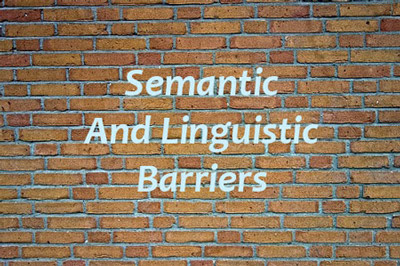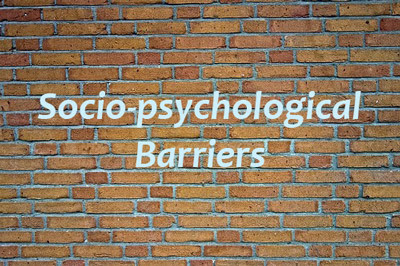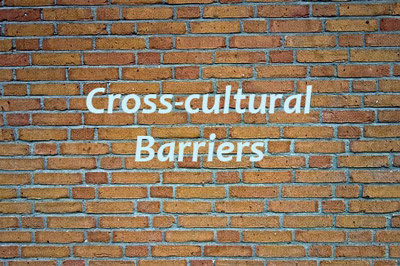➧NPK
Everybody tries to communicate effectively, but not every communication is successful. That is, there may be a difference between what is intended as the message and what is understood. The reasons for these barriers to effective communication are several, and may be classified into three board categories:
➤ Semantic and Linguistic Barriers
➤ Socio-Psychological barriers
➤ Cross-Cultural Barriers
➧ It's a knotty problem
➧ It's a naughty problem.
➧ as an invitation: Ram, come in.
➧ as a command: Ram, close the door.
➧ as a warning: Ram, be careful!
➧ as a statement of intent: Ram, we are open for discussion.
➧ as a dismissal: Ram you can leave.
➧ as an exclamation surprise: My god! Someone has broken into the house
➧ as a warning: Ram, don't do any mischievous things (lest someone should see you).
However interesting a topic, the time spent on it should not exceed the audience's patience or attention-span. On the telephone, brevity is essential. E-mails should always be brief. Brevity indicates an effort by the speaker to convey the essence of what (s) he wants to say in the best possible way. A classic example of brevity: when Gandhiji died, the writer and Nobel Laureate Pearl S. Buck remarked, "another crucifixion". In just two words, she conveyed the idea of Gandhiji as a prophet.
The cynical and negative person is not open to new ideas.
We shall now look at each of the categories of barriers to communication in detail.
Semantic And Linguistic Barriers To Effective Communication
Language is not a precise tool for thought. It needs to be handled deftly, accurately and carefully. Semantic and linguistic ability may act as barriers to effective communication.
Ambiguity in Expression
Every language has words that sound the same but have different meanings or words that sound or look very similar but are very different in meaning. Ambiguity can arise because of such words or expression, whether intentionally or unintentionally. An intentional use of such a word is commonly known as a pun.
Look at this example: They can fish here.
This can mean either
(i) they are permitted to fish here, or
(ii) they put fish into cans here (for marketing).
The word 'can' in (i) is a "modal auxiliary"; in (ii) it is a "main verb" related in meaning to the noun (a) can. There is a well-known joke about the farmer, who said about his abundant harvest of tomatoes: " We eat or sell what we can; and what we can't, we can". By now you can easily understand how the farmer is using the word can in two meaning!
Ambiguity can arise out of the careless use of the pronoun, as the following riddle illustrates:
A carpenter was instructing his overworked and underpaid helper. "I will hold the nail in place. When I nod my head, hit it hard with the hammer". What did the helper hit?
The suggestion is that the disgruntled helper hit the carpenter hard on the head (instead of the nail), "because he asked him to"!
Homophones
Words that are pronounced similarly but have different meaning are called homophones. Here are some examples.
sea, see | cite, site, sight | eye, I | wait, weight | check, cheque |
weak, week | loose, lose
A proficient listener can easily make out the meaning from the context but a not-so-proficient or inattentive listener may have problems when (s) he listens to sentences like these:
➧ It's a naughty problem.
Therefore, one should be careful in using such words in communication keeping the listener in view.
Contextual Meaning and Speech Acts
Language, as used in communication, has the property that much of the meaning is derived from the intention and the context of an utterance. Language is used to perform a "speech act" such as giving an order, extending an invitation, and so on. Thus the sentence, "Ram, the door is open" can be interpreted in at least 5 ways, depending on the context:
➧ as a command: Ram, close the door.
➧ as a warning: Ram, be careful!
➧ as a statement of intent: Ram, we are open for discussion.
➧ as a dismissal: Ram you can leave.
➧ as an exclamation surprise: My god! Someone has broken into the house
➧ as a warning: Ram, don't do any mischievous things (lest someone should see you).
Accent and Intonation
Accent - on a particular syllable in a word, or on a word in a sentence - can change the meaning drastically. In sentence,
- They stole the fruit from the garden.
- They stole the fruit from the garden
- They stole the fruit from the garden.
- They stole the fruit from the garden.
The effective use of intonation in communication - the "tune" in which something is said - can convey a meaning that is not actually said. If you hear the words "He's quite good" with a rising tone on good, commonly called "comma intonation", you get the impression that the speaker has left something unsaid: "He's quite good, but ..." What is left unsaid is usually taken to be a negative comment!
Word Shift
The meaning of a sentence can change when the position of a word is shifted.
They rang up the parent concerned. (i.e. the parent connected with the issue)
They rang up the concerned parents. (i.e. the parents who were worried)
It snows here only in winter. (at no other time than in winter)
It only snows here in winter. (it does nothing but snow during winter)
It snows only here in winter. (nowhere else does it snow)
They want the report only on bond paper. (no other paper is to be used)
Only they want the report on bond paper. (no one else does)
They want only report on bond paper. (other things need not be on bond paper)
Style
Our communication must be made in a style appropriate to the occasion. We shall distinguish mainly two styles: formal and informal. Using a formal style where the informal one is called for may create a comic effect. An informal style where a formal style is expected could be misunderstood as rudeness or lack of etiquette.
A very formal and completely unambiguous style is required in legal statements, which has to be absolute, allowing for no other possible interpretation. For example, an ordinary sentence, "I did not borrow Rs 50,000 from Mr Rao on June 6, 2006" could be made precise as follows: "I did not borrow Rs 50,000 or any other amount from Mr Rao on June 6, 2006, or on any other day". But such statements should be used only in legal parlance. Their everyday use in communication by a speaker puts him or in danger of being labelled an eccentric!
The language of a speaker in effective communication should vary according to the role he is playing. Look at the following statement, which more or less conveys the same meaning of empathy:
I feel your pain. - A politician
I hear what you are saying. - Call centre staff
I see what you mean. - A businessman
Register and Jargon - Acronyms
In certain fields, certain words have a special meaning. Those not from the field may not know that "register", or the particular meaning of a word in that field. E.g., the word instrument in the field of banking is a cheque or a demand draft; a section means a bundle of hundred notes of the same denomination.
Jorgon consists of a set of words specific to a department, field or profession. Within its field, jargon does help in keeping communication short, yet effective and even precise. There is medical jargon, legal jargon, sports jargon, trade jargon and political jargon. For people not in the field, jargon may be confusing, irritating or misleading. A stock market derivative has little to do with a mathematical derivation, and the silly mid-on and mid-off position do not appear silly to the cricket lover!
Acronyms are words made by putting together the initial letters of a descriptive name. They are usually understood only within their context: STD, PAN, PIN, NGO are common acronyms in India. What we call a PIN code is a ZIP code in America. Some acronyms, however, have attained the status of words: the word radar was originally an acronym (Radio Detection And Ranging).
Socio-Psychological Barriers To Effective Communication
The attention span of the Listener
However interesting a topic, the time spent on it should not exceed the audience's patience or attention-span. On the telephone, brevity is essential. E-mails should always be brief. Brevity indicates an effort by the speaker to convey the essence of what (s) he wants to say in the best possible way. A classic example of brevity: when Gandhiji died, the writer and Nobel Laureate Pearl S. Buck remarked, "another crucifixion". In just two words, she conveyed the idea of Gandhiji as a prophet.
Laughter, the Best Medicine!
Whether in teaching or talking, a smile always complements the message. Even a difficult concept can be conveyed through humour. Occasional jokes and anecdotes embellish the talk. Eye-contact and a smile give the listeners a feeling of togetherness.
When some people are clearly getting impatient, an appropriate joke changes the mood of the group immediately. Here is an example. A member of an audience looked at his watch during a speech. The speaker quipped: "I don't mind if someone looks at their watch. But I do get offended if they hold it to their ear to see if it has stopped!"
External Disturbances and the Wrong Medium
Noise from the surroundings or mechanical failures can sabotage effective communication. A school used to hold an annual drama week in its open courtyard in the evening. Music blaring from a local place of worship forced the rescheduling of the performances to the morning! People who use computerized presentations need to have a backup plan in case their equipment is mismatched with the host's facilities, or in case there is no assured power supply during their presentation.
Each mode or medium of communication has its characteristic strengths and weakness. A talk filled with statics is eminently forgettable if it is not supplemented with visual such as the pie-diagrams and bar-graphs. Think of our irritation when cricket scores are given verbally in the television commentary rather than being flashed on the screen!
Personal Bias and Strong Feelings
People who have strong feelings about certain issues or people may be ineffective listeners or readers. Their emotion will bias or cloud the message. Similarly, a speaker who has very strong convictions may tend to speak in absolute terms, or in a didactic tone.
Selectivity, or the 'I see Only What I want to See' Attitude
The attitude is very dangerous because the resulting miscommunication can remain undetected. The speaker may have spoken well, and the listener may even confirm that (s) he has understood something very clearly. But what has been understood may be quite different from what was meant to be understood. The following anecdote illustrates this.
A priest wanted to demonstrate to his congregation the harmful effects of alcohol. He half-filled a glass with alcohol and dropped an insect into it, which struggled and died. The beaming priest asked a person in the gathering, "So, what can you infer from this?"
The man rose to his feet and replied, "If we take alcohol occasionally, the worms in the belly will die!".
Cynicism and Negativity
The cynical and negative person is not open to new ideas.
Counsellor: To gain self-confidence, you must avoid using negative words such as can't and not. Do you think you could do that?
Young man: Well, I can't see why not!
Perceived Benefits
For effective two-way communication, we need an attentive and interested audience. It is necessary for the communicator to ensure that the topic of the talk is of some relevance to the audience. If they don't perceive any benefit to them, the listener(s) may soon lose interest.
Cross-Cultural Barriers To Effective Communication
Being able to speak correct English with a 'correct' or 'proper' accent is no longer adequate. The ability to understand different accents, idioms ever expanding jargons and expressions - all these cultural differences make up the skills that have to be acquired to overcome the barriers to effective communication.
One should also be aware of the culture of the others, especially when they are our guests or when we are in their country. These can be a variety of matters. Behaviours such as seeing people ignoring red traffic lights, spitting on the floor, smoking in public or queuing for a bus. All depending on one's own culture may appear as weird, strange, rude, ignorant or simply silly.
For example, why do the English queue for everything? This relates to their approach to fairness, justice, order the rights. The rationale behind the queue is that those that get there first should be right be served first or get on the bus first. Many other cultures simply do not queue in this manner as it is not part of their cultural programming.
Greeting people, shaking hands, offering food, expressing gratitude, eye contact, body language, colour codes are some of the areas one has to observe and gain 'cultural knowledge'. Such sensitivity towards other cultures helps us to communicate across cultures effectively. Awareness of other cultures does not mean losing the identity of one's own culture. One can maintain his cultural identity and yet be a successful communicator across cultures.
How To Overcome The Barriers To Effective Communication
The Six Wh-s That See You Through As a Communicator
In a profession or maybe even in life, six Wh-s hold the golden key to successful communication. They are complementary to each other and not mutually exclusive.
Before speaking we should ask ourselves the following questions
➤ Why am I communicating?
➤ Where am I communicating?
➤ When am I communicating?
➤ How should I communicate?
➤ What am I communicating?
➤ With whom am I communicating?
These questions are important because when the place changes our status too changes. We may not be treated the same way as we are treated in our place. Even a good thing said at a wrong time may not attract the other's attention, because the time is inconvenient for them or unsuitable for them. If the communication is purposeless or not required by the others, we may not interest them.
Conclusion
In spite of language proficiency, communication fails or at least is not effective. The factors that act as barriers to effective communication can be classified
➤ linguistic and semantic barriers to effective communication
➤ socio-psychological barriers to effective communication
➤ cross-cultural barriers to effective communication
Some of the linguistic semantic barriers are ambiguity, accent, pitch, use of acronyms, careless word shift, wrong intonation, use of jargon, idioms.
Some of the socio-psychological barriers are choice of the wrong medium, lack of humour, time constraint, inhibitions, no perceived benefit to the audience, the absence of body language or wrong use of body language.
Barriers to the cross-cultural communication may arise from variation among cultures in the meanings attached to gestures, symbols or body language.
Cross-cultural barriers include the inability to understand signals in other cultures, attaching meanings as per one's own culture, not developing sensitivity to other cultures, space distancing, selectivity or "I see what I want to see" attitude.
To be a good communicator, one should remember the six Wh-s – With Whom? Where? When? How? Why?






ConversionConversion EmoticonEmoticon